Birds of Rhodesia
by R. W. RANKINE, M.B.O.U., M.S.A.O.S.
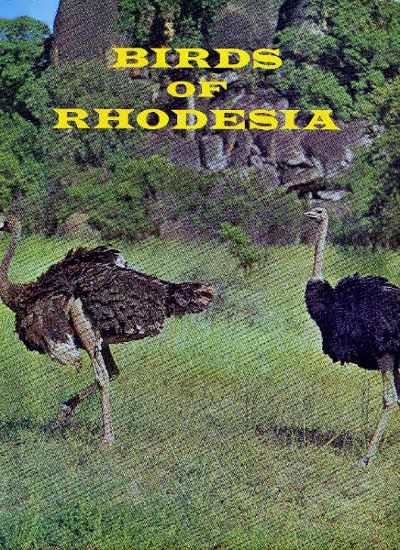 /'
/'Above: OSTRICH. Largest living bird, height 7-8 ft.; flightless; ground speed of 30 m.p.h. or more; male largely black with beautiful soft flight feathers, female brown. Conspicuous cock incubates eggsat night, inconspicuous hen by day. Predominantly vegetarian, eats hard objects to aid digestion. Clutch 15-20 giant eggs, commonly attacked by jackals; well-distributed in open grassland and lightly wooded country, but becoming more scarce.
Birds have always exercised a distinct fascination for man, even since his earliest days. In Rhodesia some of the first people to show this interest must have been the early bushmen, for many species have been identified from their rock paintings, which can be found all over the country.
Rhodesia is spectacularly well-endowed with bird life. Unfortunately, therefore, this series of pictures can show only a representative selection of the 620 species at present on the ornithological Checklist*. Of the 620, 80 are migrants, others are probably subtropical migrants, and 460 or more have been found to nest here. Of the 80 migrants, many come to Rhodesia, like the tourist, to escape the European winter, some completing epic journeys of as far as 14,000 miles annually to and from their northern breeding-grounds.
In contrast to that of many other countries, our bird population is unlikely to diminish: there is little cause for concern about the preservation of our birds, and, happily, no species is in danger of dying out.
For the visitor, it is interesting to compare the various types of Rhodesian birds with those overseas. In Europe, birds such as the cuckoo are known to form a single species. Here we have 11 cuckoos, 9 kingfishers, 13 swallows, 26 larks, 8 robins and 17 eagles, to mention just a few.
Although particularly abundant in Rhodesia's many national parks, birds may be seen every where, varying of course in different areas according, mainly, to climate and altitude. Contrary to expectations, the well-watered areas have fewer birds on the whole than the drier ones.
The best time to see birds is in the early morning, when they are feeding and on the move. At this time of day there is an abundance of birdsong, and the trees are enlivened with flashes of brightly coloured plumage. Later in the day, towards 10 a.m., most seem to disappear; they rest until about 4 p.m., when they will be found on the move again until sunset.
The diversity of our bird life has been amply illustrated by bird counts carried out by ornithologists in various areas of Rhodesia. On several occasions the watchers have listed more than 150 species in a single day.
In Britain it requires exceptional powers of observation to see more than 100 species in a year!
One of Rhodesia's most interesting birds is the Honey Guide. Joao dos Santos, writing in 1569, was the first to record this bird as leading people to bees' nests. He also stated that the bird flew in through the open church-windows at Sofala, in Mozambique, to eat the wax candles on the altar.
There are several species of the Honey Guide in Rhodesia, but only two of them lead to bees nests, and only one does so regularly.
Of the many spectacular and brightly coloured birds we have, the crimson-breasted shrike, the gorgeous bush-shrike and the common blue jay (a species of roller) are particularly outstanding.
Nor should we overlook the louries, with their green-and-purple plumage and scarlet wing feathers; the sunbirds; the bee- eaters; or the bright little waxbills.
As for songbirds, Rhodesia is often discount- ed as having none; but the belief is untrue. Although perhaps not so well known as the lark or nightingale immortalised in songs and poems, some of our robins, buntings, warblers, canaries and finches nonetheless sing beautifully. Many other birds are remarkable for their distinctive calls: among them are the "Go-away" bird (the grey lourie), the "Piet my vrou" (red- chested cuckoo) and the fish eagle, whose lovely call is known to most Rhodesians.
Practically every bird here extends its range to other countries, either to the north or= south, except one, the Swynncrton's robin. This bird wc can truly call our own, for it lives in the higher mountain forests along the eastern border, with a small population across the border in Mozambique.
Every year, in view of the large number of new dams and the growing number of bird enthusiasts, a few new species are added to our list. So far, 1967 has yielded two—the Cape eagle owl and the red-capped crombec. This progress will continue for many years and it would be unwise to forecast the date when the last record will be entered of the birds of Rhodesia.
End
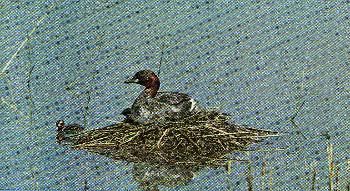
Above: CAPE DABCHICK. Smallest grebe; length 6 in.; frequents small open sheets of water, swimming over surface in search of small water animals; floating nest of weeds; chicks can swim and dive on first day. Common in pairs or small parties throughout.
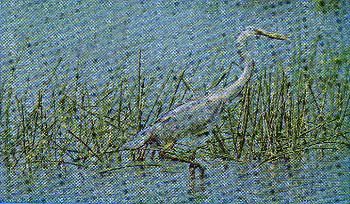
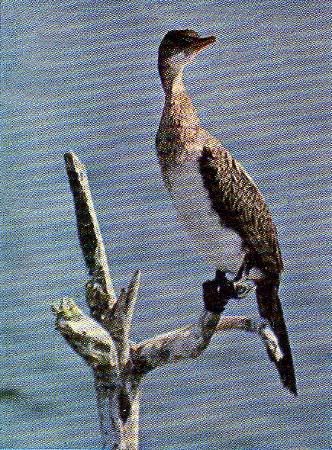
Above: WHITE-BREASTED CORMORANT (juvenile). Common on all larger areas of water in Rhodesia. Eats fish and occasionally frogs. Catches prey by swimming under water. Nest in colonies, mainly in trees. Adult bird has completely white throat, chest and belly.
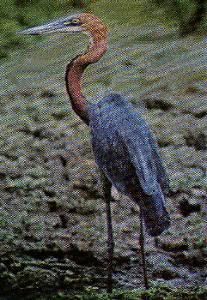
Above: GOLIATH HERON. Largest heron. Slow flight with ponderous wing-beats and sagging legs; rather shy; generally haunts quieter areas of rivers and vleis. Diet: mainly fish. Nest at least 3 ft in diameter. Regionally common singly or in pairs.
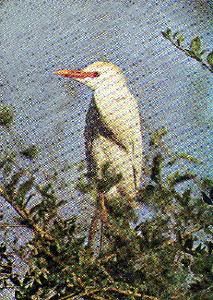
Above: CATTLE EGRET. Smallest white egret, under 2 ft.; commonly known as the "Tickbird", but true tick bird is the Oxpecker; frequently accompanies cattle and large game for the insects they disturb; nesting rare, but widely distributed and common.
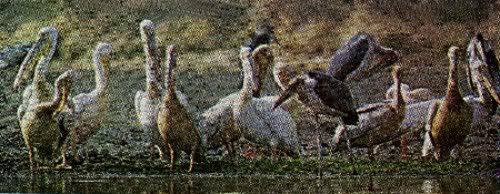
Above: WHITE PELICANS. One of two species occurring here; length nearly 6 ft Capture diet of fish by assembling in large flocks in true formation driving fish into shallows and scooping up into naked pouch. Surprising powers of flight. Found mainly Lowveld rivers, Zambezi. Not common.
MARABOU STORK. Tall carrion bird of repulsive, mangy appearance. Characteristic upright stance and guttural croak; has adopted to large extent habits of vultures; feared by them on account of powerful bill; it takes precedenceat carcase. Food: carrion, termites, locusts, fish, frogs, lizards, snakes and rats. Fairly common, singly or in small communities, especially in Lowveld, where it nests in large trees.
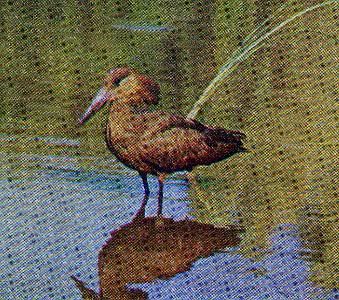
Above: HAMMERKOP Peculiar to Africa; one of nature's curiosities and regarded with superstitious awe by Africans; part heron, part stork, it subsists mainly on frogs and fish in open shallows. Intricate nest of large, hollow dome with inac- cessible opening, taking about 6 months to construct. Common.
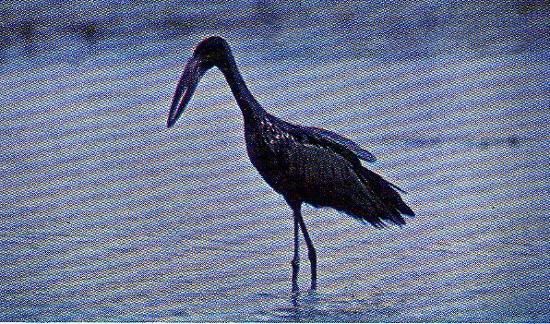
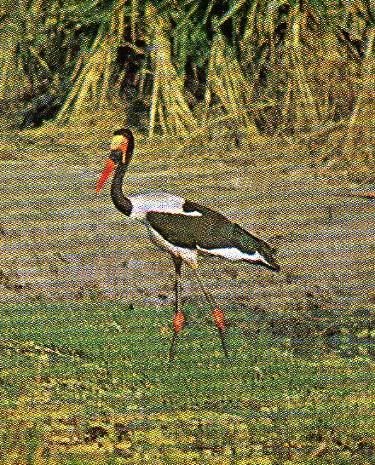
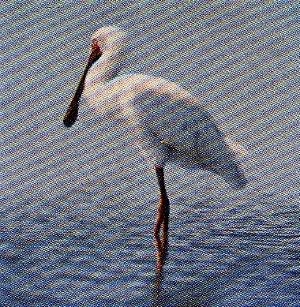
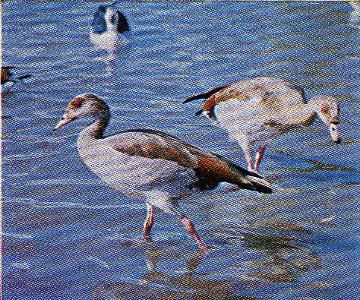
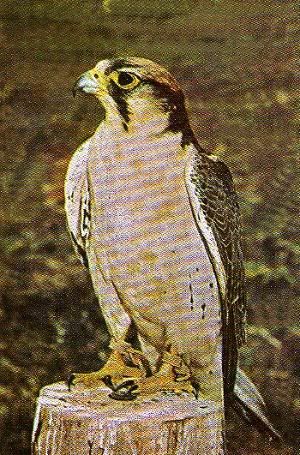
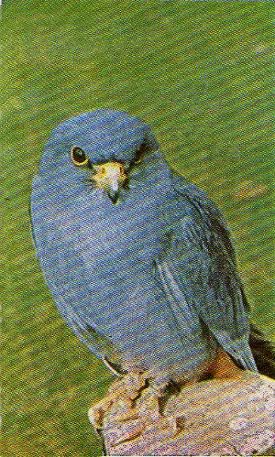
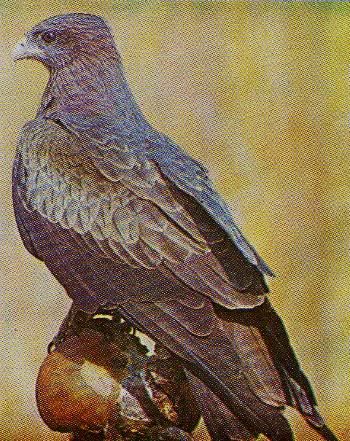
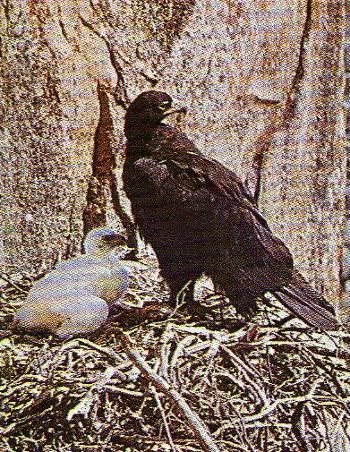
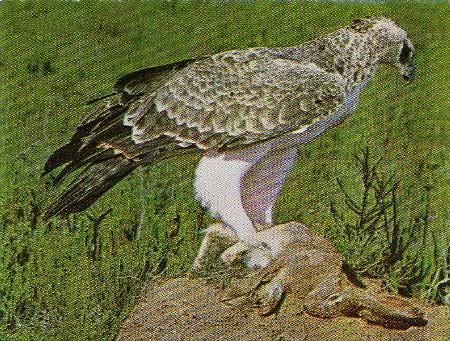
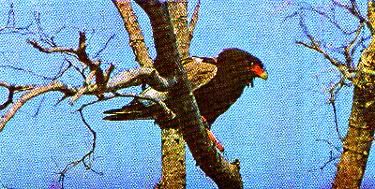
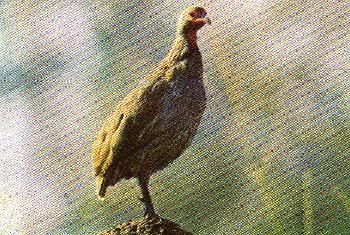
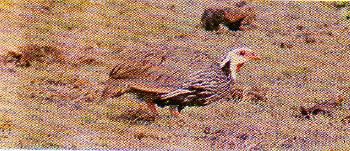

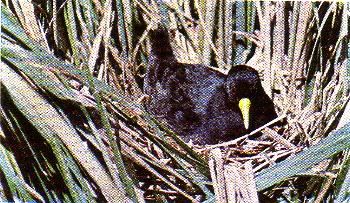
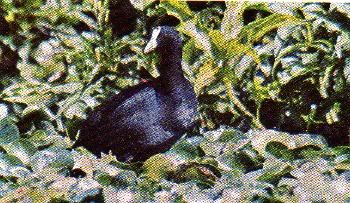
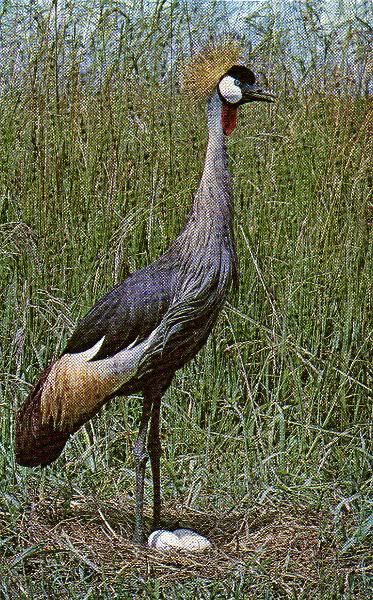
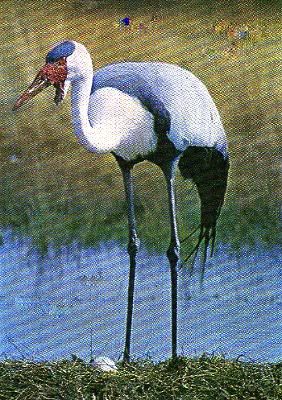
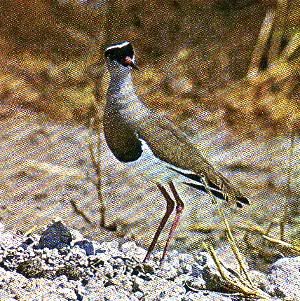

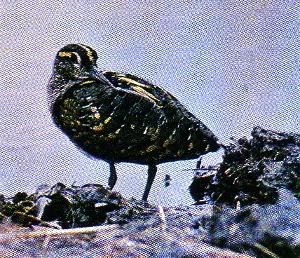
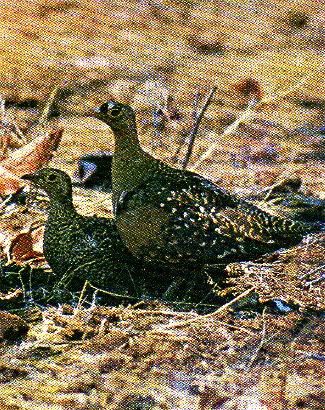

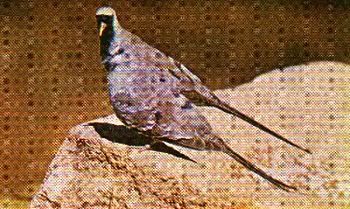
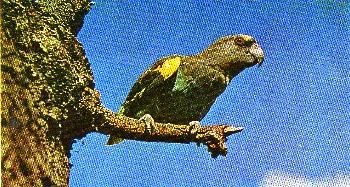
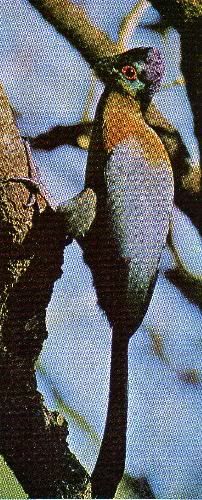

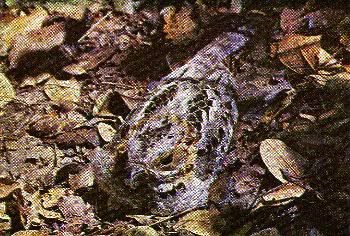
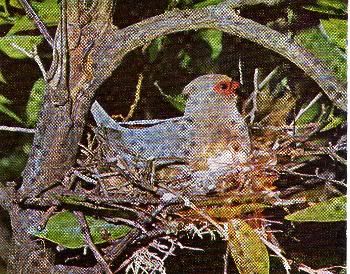
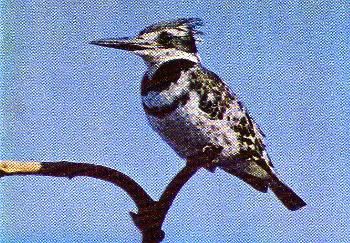


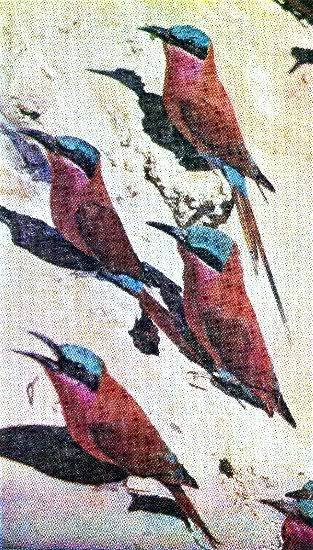
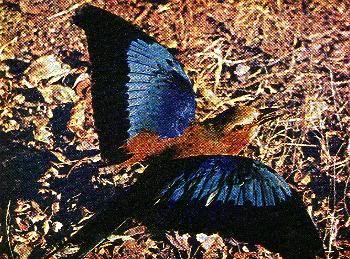
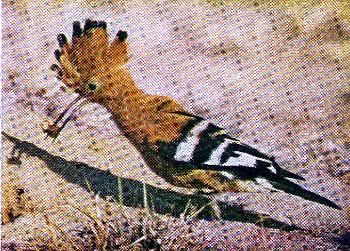
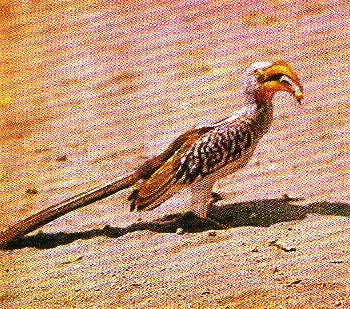
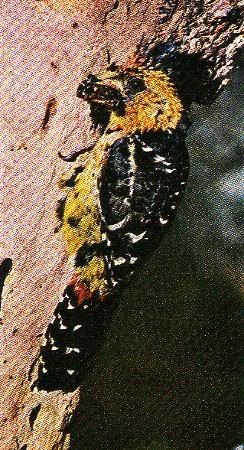
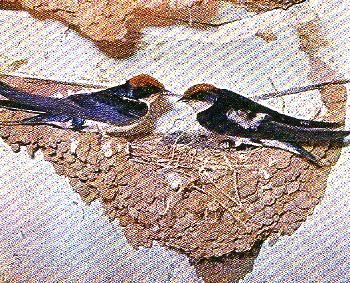
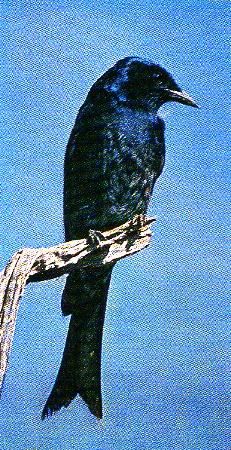

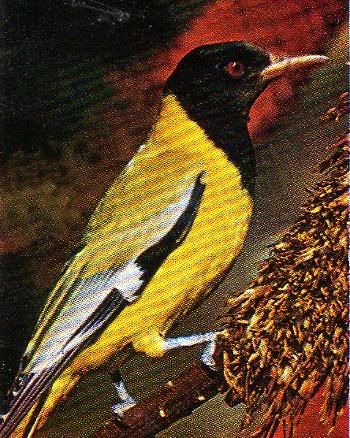

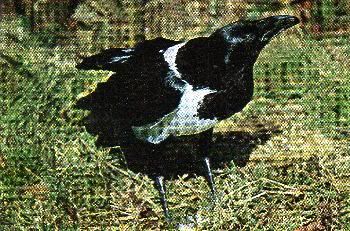
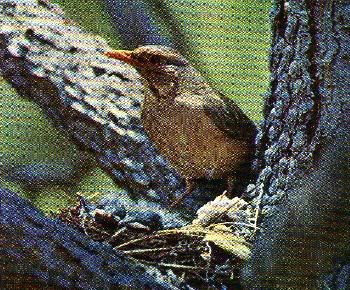
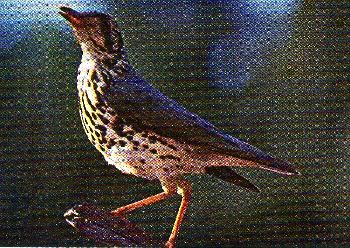
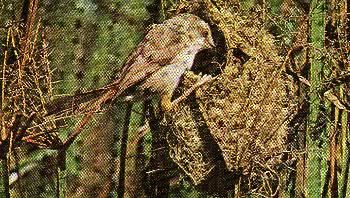
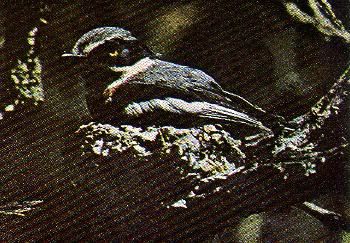

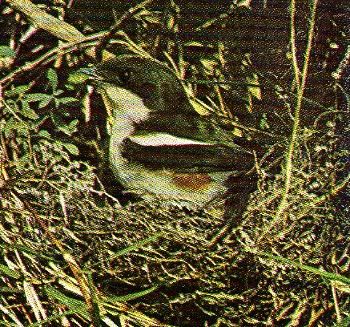
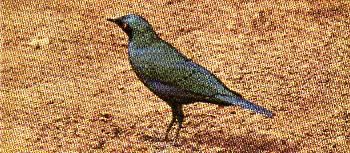
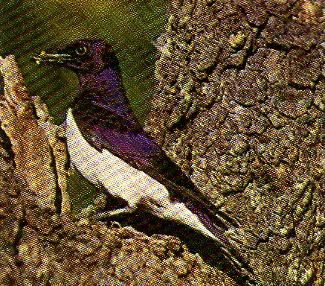

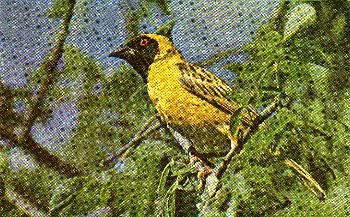

Above: RED-BILLED QUELEA. Unmistakable; main menace to seed-growing farmers throughout Africa. Swift-flying flocks sometimes number millions (lower picture); nests in hundreds of thousands; mainly low-lying areas; widely distributed.
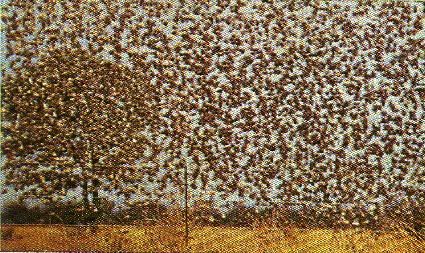
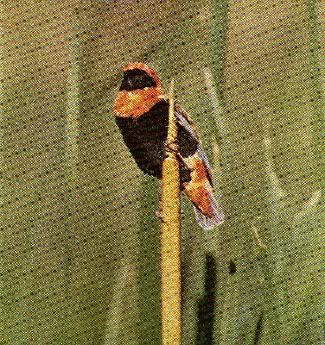
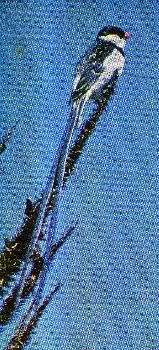
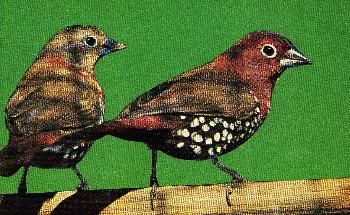
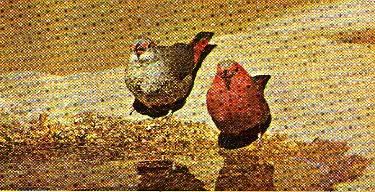
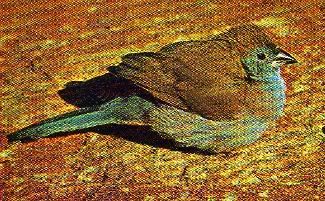
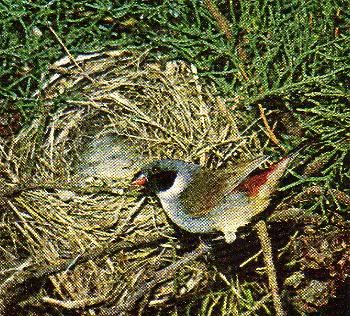
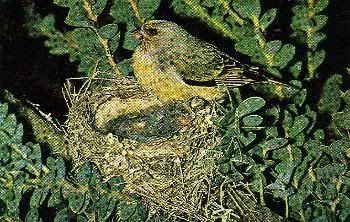
END OF ARTICLE
This guide reprinted from Rhodesia Calls by Graphic Printers, Rhodesia, and published by the Rhodesia National Tourist Board.
Extracted and recompiled by Eddy Norris for use on "Our Rhodesian Heritage" blog.
* The birds shown in the pictures arc named according to the listing in Roberts* Birds of Southern Africa.
In contrast to that of many other countries, our bird population is unlikely to diminish: there is little cause for concern about the preservation of our birds, and, happily, no species is in danger of dying out.
For the visitor, it is interesting to compare the various types of Rhodesian birds with those overseas. In Europe, birds such as the cuckoo are known to form a single species. Here we have 11 cuckoos, 9 kingfishers, 13 swallows, 26 larks, 8 robins and 17 eagles, to mention just a few.
Although particularly abundant in Rhodesia's many national parks, birds may be seen every where, varying of course in different areas according, mainly, to climate and altitude. Contrary to expectations, the well-watered areas have fewer birds on the whole than the drier ones.
The best time to see birds is in the early morning, when they are feeding and on the move. At this time of day there is an abundance of birdsong, and the trees are enlivened with flashes of brightly coloured plumage. Later in the day, towards 10 a.m., most seem to disappear; they rest until about 4 p.m., when they will be found on the move again until sunset.
The diversity of our bird life has been amply illustrated by bird counts carried out by ornithologists in various areas of Rhodesia. On several occasions the watchers have listed more than 150 species in a single day.
In Britain it requires exceptional powers of observation to see more than 100 species in a year!
One of Rhodesia's most interesting birds is the Honey Guide. Joao dos Santos, writing in 1569, was the first to record this bird as leading people to bees' nests. He also stated that the bird flew in through the open church-windows at Sofala, in Mozambique, to eat the wax candles on the altar.
There are several species of the Honey Guide in Rhodesia, but only two of them lead to bees nests, and only one does so regularly.
Of the many spectacular and brightly coloured birds we have, the crimson-breasted shrike, the gorgeous bush-shrike and the common blue jay (a species of roller) are particularly outstanding.
Nor should we overlook the louries, with their green-and-purple plumage and scarlet wing feathers; the sunbirds; the bee- eaters; or the bright little waxbills.
As for songbirds, Rhodesia is often discount- ed as having none; but the belief is untrue. Although perhaps not so well known as the lark or nightingale immortalised in songs and poems, some of our robins, buntings, warblers, canaries and finches nonetheless sing beautifully. Many other birds are remarkable for their distinctive calls: among them are the "Go-away" bird (the grey lourie), the "Piet my vrou" (red- chested cuckoo) and the fish eagle, whose lovely call is known to most Rhodesians.
Practically every bird here extends its range to other countries, either to the north or= south, except one, the Swynncrton's robin. This bird wc can truly call our own, for it lives in the higher mountain forests along the eastern border, with a small population across the border in Mozambique.
Every year, in view of the large number of new dams and the growing number of bird enthusiasts, a few new species are added to our list. So far, 1967 has yielded two—the Cape eagle owl and the red-capped crombec. This progress will continue for many years and it would be unwise to forecast the date when the last record will be entered of the birds of Rhodesia.
End

Above: CAPE DABCHICK. Smallest grebe; length 6 in.; frequents small open sheets of water, swimming over surface in search of small water animals; floating nest of weeds; chicks can swim and dive on first day. Common in pairs or small parties throughout.

GREY HERON. Grey but with white neck; shy, resident, species; stands motionless for long periods while feeding; mainly fish diet. Drops down in long spiral flights to roost or nest. Mutual vociferous greeting on nesting; usually in colonies. One of the commonest herons.

Above: WHITE-BREASTED CORMORANT (juvenile). Common on all larger areas of water in Rhodesia. Eats fish and occasionally frogs. Catches prey by swimming under water. Nest in colonies, mainly in trees. Adult bird has completely white throat, chest and belly.

Above: GOLIATH HERON. Largest heron. Slow flight with ponderous wing-beats and sagging legs; rather shy; generally haunts quieter areas of rivers and vleis. Diet: mainly fish. Nest at least 3 ft in diameter. Regionally common singly or in pairs.

Above: CATTLE EGRET. Smallest white egret, under 2 ft.; commonly known as the "Tickbird", but true tick bird is the Oxpecker; frequently accompanies cattle and large game for the insects they disturb; nesting rare, but widely distributed and common.

Above: WHITE PELICANS. One of two species occurring here; length nearly 6 ft Capture diet of fish by assembling in large flocks in true formation driving fish into shallows and scooping up into naked pouch. Surprising powers of flight. Found mainly Lowveld rivers, Zambezi. Not common.
MARABOU STORK. Tall carrion bird of repulsive, mangy appearance. Characteristic upright stance and guttural croak; has adopted to large extent habits of vultures; feared by them on account of powerful bill; it takes precedenceat carcase. Food: carrion, termites, locusts, fish, frogs, lizards, snakes and rats. Fairly common, singly or in small communities, especially in Lowveld, where it nests in large trees.

Above: HAMMERKOP Peculiar to Africa; one of nature's curiosities and regarded with superstitious awe by Africans; part heron, part stork, it subsists mainly on frogs and fish in open shallows. Intricate nest of large, hollow dome with inac- cessible opening, taking about 6 months to construct. Common.

Above: OPENBILL. Large-billed stork with sailing flight and projecting legs. Uses bill as nutcracker for diet of snails and fresh-water mussels. Individual feathers resemble cellophane. No record of voice. Gregarious except when feeding and partially nocturnal; appears in large flocks on Lowveld rivers, breeding recorded Gwaai River, Lowveld. Uncommon.

Above: SADDLEBILL. Largest Rhodesian stork, length nearly 6 ft., Distinctive appearance, male has scarlet eyes, female yellow; Ponderous flight; stalks around marshy areas or water in search of food. Breeds Rhodesia; commonest lower areas.
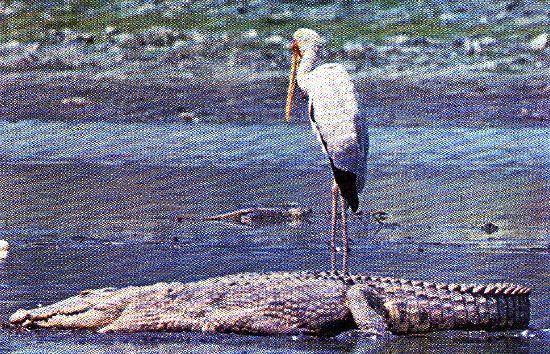

Above: WOOD IBIS. Distinguished from European "baby-carrying" stork by yellow "Roman-nose" bill, red facialpatch and black tail. Comparatively tame and often seen when not feeding with herons, spoonbills and other large waders. Probes for aquatic insects, fish and frogs, often with head totally submerged. Voice like squeaky hinge. Commonly occurs in small parties, especially in Lowveld, but well distributed throughout.
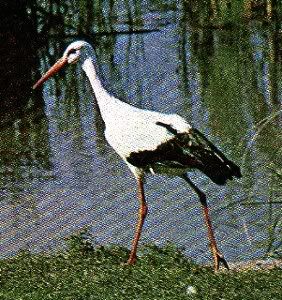

Above: WHITE STORK. Palearctic migrant arriving at beginning of rains, leaving end of March. General open vleis and grassland, performing useful function of devouring locusts, caterpillars, and army worms, lumbers decreasing.

Above: SPOONBILL. Flattened spatula bill, long legs and shy habits; frequents water or marshes, probing into mud or sweeping bill from side to side while feeding; beautifully blotched eggs. Nests upper Zambezi; commonest Lowveld, Zambezi Valley.

Above: EGYPTIAN GOOSE. Pronouneed rim round eye distinguishes it from other geese; frequently seen near water but also occurs in vast flocks in open lands. Commonly uses the old nests of other species, e.g. hammerkop; nests during cold weather. Resident; common throughout.
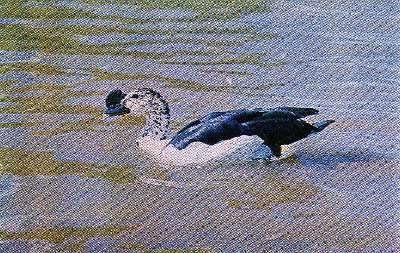
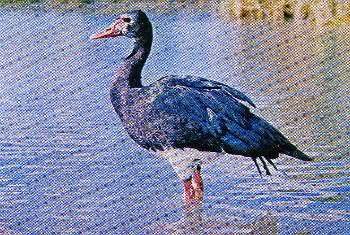
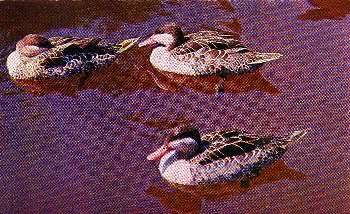
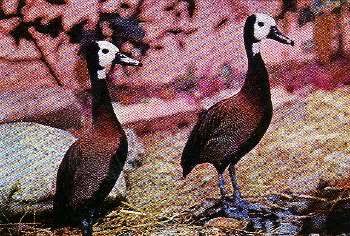
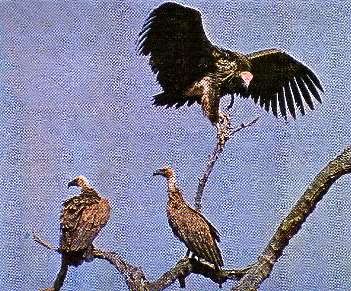
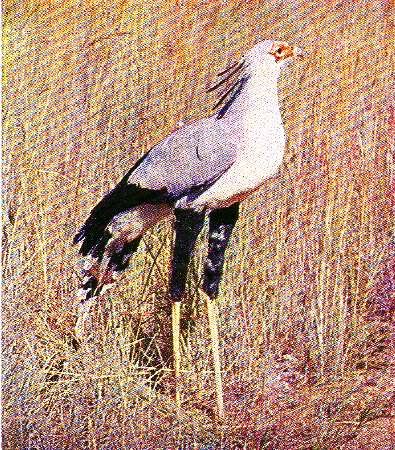

Above: KNOB-BILLED DUCK. Relatively large duck of conspicuous appearance. Commonly flies in "V" formation with characteristic swishing sound and deceptively slow wing beats. Frequent short hoarse whistle. Food: Water plants and insects, grass seeds and grain. Probably migratory with considerable local movements. Common.

Above: SPURWING GOOSE. Largest resident goose. Notoriously wary, hard to shoot and sometimes tough to eat. High-pitched whistle in flight. Feeds on vegetable matter, normally at night. Gregarious and common on larger stretches of water, congregating in flooded areas after rains.

Above: RED-BILL TEAL. Distinguished from Hottentot Teal by pink bill and larger size. Active species, not very shy. Food: aquatic plants and insects, small frogs and fish. Highly gregarious, usually found on all small dams. Commonest resident duck.

Above: WHITE-FACED DUCK. Active feeders and fliers by night, resting by day.Somewhat wary, whistling and circling when alarmed. Ponderous flight. Distinctive clear whistle. Aquatic food, grass seeds. Gregarious resident species widespread in Matabeleland. Common during rains.

Above: BLACK VULTURE (Outstretched wings). Huge turkey-head vulture held in awe by other species, hence old name "King Vulture'*; usually drives off other vultures at carcass until full, but feeds less grossly. Voice: a sharp yelp. Seldom more than two or three seen carcass but species general and common.
WHITE-BACKED VULTURE (perched). Gathers in large numbers at carcass, fighting, squealing and hissing; eyes and mouth of carcass attacked first, flesh extracted through holes in skin into which bird inserts whole head and neck. Commonest vulture throughout.

Above: SECRETARY BIRD. Peculiar to savanna veld of Africa south of Sahara.Resembles scribe with quill pen behind ear. Terrestrial habits and considerable running speed; also powerful flier. Voice: deep croak. Partial to snakes, attacks with feet. Well distributed, not common.

Above: LANNER FALCON. Magnificent flier, swooping at prey; trained for falconry. Voice: loud, metallic "chack, chack, chack". Food: birds, reptiles, insects, especially locusts. Nests during winter on rocky cliffs, or old eagles' nests. Common.

Above: EASTERN RED-FOOTED KESTREL. Migrates from Manchuria and Siberia in large flocks from August to March. Voice: "ki-ki- ki-ki-ki". Food: termites, insects, small mammals. Chiefly seen Mashonaland.

Above: YELLOW-BILLED KITE. Graceful sailing flier, steering and changing direction by means of tail. Daring, omnivorous thief, even snatching food from baskets on the heads of Africans, Large stick nest, lined with dung, rags, wool, etc. Common, also found near towns and villages.

Above: BLACK EAGLE (VERREAUX's) (left). Magnificent large eagle with yellow feet and bill. Particularly graceful in flight. Unusual yelping call. Uses element of surprise in capturing prey, mainly hyrax and other small animals. Common resident of rocky kopjes; plentiful in Matopos.

Above: MARTIAL EAGLE. Largest eagle. Strong and rapacious; executes larger kills with powerful swoop, often killing on impact. Voice: loud, ringing, repetitive "Kloo-ee". Food: often game birds and small animals. Nest may measure 6 ft. across. Widely distributed and relatively common in open country.

Above: BATELEUR. Perhaps our most beautiful eagle; adopted as insignia of Royal Rhodesian Air Force. Richly coloured and distinctive in the air; rocks from side to side as it steers, performing impressive aerobatics Voice: short, sharp bark. One of at least 67 species occurring in Southern Africa. Common and well distributed throughout Rhodesia.

Above: SWAINSON'S FRANCOLIN. Robust game bird. Absence of white striping on belly differentiates from red-necked francolin. Voice: rising and diminishing "kwahli". Food: seeds, bulbs, insects. Usually seen in small family parties near streams or waterholes. Commoner in Matabeleland.

Above: RED-NECKED FRANCOLIN. Replaces Swainson's francolin in the Eastern Districts and Victoria Province. Used to be much more common, but has retreated with the increase in agricultural activity.

Above: CROWNED GUINEA FOWL. Horny casque distinctive. Great runners when disturbed, taking refuge in grass, bush or trees; alarm note: rattling "kek, kek". Food: varied; useful to farmers, consuming masses of grubs and insects. Excellent table bird; prior hanging or marinating recommended. The commonest and most valuable game bird.

Above: BLACK CRAKE. Small, unmistakable. Bolder than the other crakes. Flies low over water, treads water plants like the jacana. Voice: deep, growling "churr". Food: Insects, seeds, aquatic plants, snails, small fish. Usually in pairs or small parties. Commonest riverside rail.

Above: RED-KNOBBED COOT, Pugnacious and commonly seen in large parties swimming, chasing each other and belly-skating across water. Flies strongly when necessary. Often identified by a strange, humming "Vvvv". Food: insects, aquatic plants. Common throughout on larger open waters.

Above: CROWNED CRANE. Stately crane with magnificent golden crest. Indulges in playful dances and gambols often imitated in certain African dances. Trumpeting "Mahem" call gives it its African and Afrikaans name. Often domesticated. Food: small animals, insects, grain. Resident on the highveld, frequenting swampy borders in pairs and small parties.

Above: WATTLED CRANE . Largest crane. Distinctive wattles and lovely pink eye. Very wary. Terrestrial habits as of crowned crane. Voice: drawling, guttural "hornk". Food: small reptiles, frogs, insects, etc. Nests by choice on islets well out of range of jackals. Large flocks occur on swampy highveld borders and adjoining grassveld.
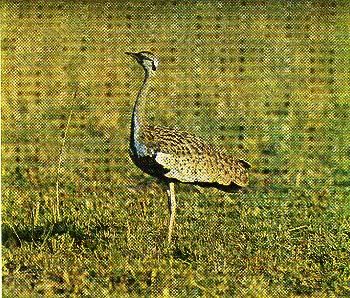
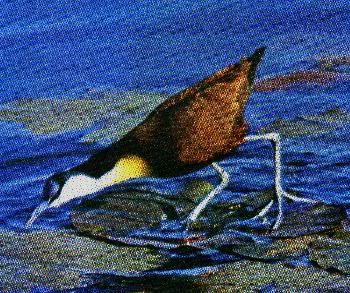

Above: BLACK-BELLIED KORHAAN. Thin-necked, long - legged member of bustard family. Spectacular in flight, dropping with wings over back. Rather tame and difficult to flush. Voice: drawling whistle, followed by a pause and cork-like pop. Food: insects, particularly dung beetles. Widely distributed in light woodland and open grassland.

Above: AFRICAN JACANA. (lily trotter). Two species occur in Africa. Unmistakable elongated toes and claws, used in running over floating vegetation, dives and swims. Food: water insects, seeds. Remarkably glossy eggs; floating nest of scanty material. Common wherever water-lilies occur.

Above: CROWNED PLOVER. Black crown, red legs, like other plovers given to running in starts. Noisy and attentive to intruders, swooping at them with wild cries. Food: beetles, grasshoppers, insect larvae. Common resident of short open grassveld and cultivations. Probably our commonest plover.

Above: THREE-BANDED SANDPLOVER. High pitched call often heard first, accompanied by bobbing head and body. Flight jerky. Food: insects and larvae. Probably commonest sandplover, nesting at edge of water.

Above: PAINTED SNIPE. Hen strikingly beautiful, larger than male; latter incubates and cares for young. Remarkable camouflage. Remains stationary when alarmed. Widely distributed but sparse.
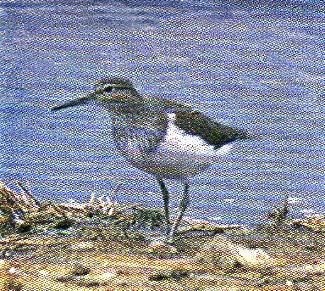
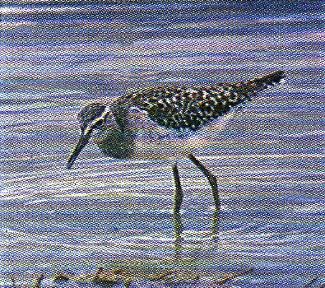
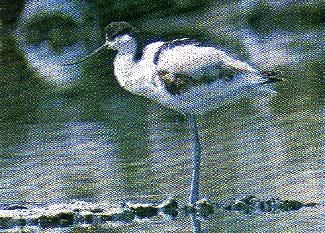
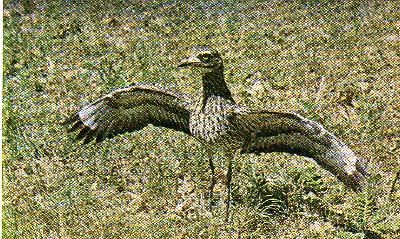

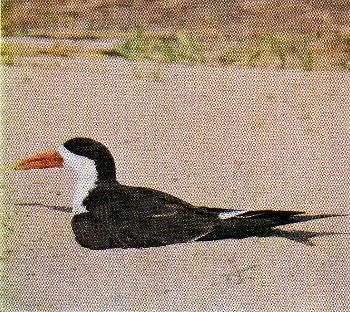

Above: COMMON SANDPIPER. Palearctic migrant from North, some remaining throughout year. A wader, probing bill into mud in search of insects, larvae, etc.; characteristic bobbing of hinder part of body; widespread and common by quieter waters.

Above: WOOD SANDPIPER. Speckle-backed. Wades along grassy marshes, pools and streams pecking at insects, frogs and fish. Common palearctic migrant, but some stay in Rhodesia throughout the year.

Above: AVOCET (Awl-Bill). Distinctive upturned bill. Numbers fly in close formation, often alighting on water; swim and upend like ducks in deep water; feed with scythe-like action of beak in shallows. Restless species, some migratory, some resident. Commonest lowveld. Picture shows juvenile.

Above: DIKKOP (THICK-KNEED PLOVER). Both water and Cape dikkop occur here. Similar appearance; erepuscular and nocturnal in habits; squat among rocks and herbage by day. Food; insects, small animals.

Above: TEMMINCK'S COURSER. Small red-brown, plover-like bird witlr long whitish legs. Always running. Voice: metallic "err-err-err". Food: mostly insects. Restless; very common on burnt-off grass or shorter grassveld

Above: AFRICAN SKIMMER (Scissor-Billed Tern). Only skimmer in Africa. Forked tail, long wings. Flies swiftly, skimming low over water, especially at dawn and dusk, and dipping bill on sighting fish.

Above: DOUBLE-BANDED SANDGROUSE. Short bill and legs. Considered a "game bird". Loud "chuck-chuck" call when flushed. Food: mainly hard seeds. Pair off in breeding season. Flocks congregate at waterholes at dawn and dusk. Especially common in drier mopane country.

Above: CAPE TURTLE-DOVE. Colour variable. Well-known "how's father" call; spends the majority of its time on the ground picking up grain and seeds; characteristic habit of bobbing its head back and forth with each step. Climbs steeply, spiralling in descent. Common.

Above: NAMAQUA DOVE. One of the smallest doves. Exceptionally long tail; male has dark face and yellow bill. Delightful aviary bird. Flies swiftly, displaying cinnamon wings. Walks rather hunched up when searching for weed seeds, usually on old cultivated lands or gardens. Perches and nests very low. Commonest in arid districts.

Above: MEYER'S PARROT. Distinguished from Cape parrot by green rump and belly. Flies fast. Shrieking call. Food: fruit, berries, maize. Good pet, but rarely taught to talk. Nests in natural holes in trees. Usually in small parties in woodlands not far from water. Commonest of our three parrots. Both sexes similar, younger bird paler in colour.

Above: PURPLE-CRESTED LOURIE. Strikingly beautiful, especi- ally with scarlet wings displayed in flight. Hops on branches as if on springs. Loud attractive voice, commencing like English pheasant and ending in continuous "kooking" call. Food: fruit. Frequents riverine forest and woodlands.
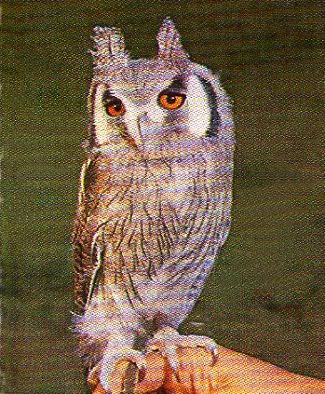

Above: WHITE-FACED OWLET. Longish ears, perches by day in dark trees. Voice: typical owl hoot commencing in a stutter. Food: largely insects. Normally uses hawks' or other birds' nests. Widely distributed in pairs in woodlands.

SPOTTED EAGLE OWL. One of the commonest large owls. Rests by day among rocks or large trees, emerging at dusk. Voice: loud "hu-hoo". Food: mainly rodents and insects. Very common in dense woodlands.

Above: SOUTH AFRICAN NIGHTJAR. Nocturnal, lethargic. All species alike and similarly coloured; this nightjar having more rufous colouring around the head. Continuous "wheeting" call, a familiar woodland sound on moonlit nights. Food: insects, taken from fixed perch. Woodland habitat. Commonest nightjar.

Above:RED-FACED MOUSEBIRD (Coly"). Prettiest mousebird and strongest in flight, with rapid wing; beats. When disturbed fly off in sequence, crashing into neighbouring bush. Adopt hanging position on perch. Creep mouselike on branches while feeding. Menace to fruit growers. Wonderful pet. Common.

Above: PIED KINGFISHER. One of our commonest kingfishers. Conspicuous habit of hovering over water and diving head first to capture prey. Carries latter to favourite perch, usually beating it to death before swallowing It. Nests in holes in bank. Common throughout Rhodesia.

Above:NATAL KINGFISHER. Brilliantly coloured. Resembles European species. Perches low on reeds, diving; for prey. Dry-land non-fishing species very similar to the fish-eating malachite kingfisher. Call: shrill "chip" when flying. Food: mainly insects. Nests in holes in banks. Common in thick bush country.


Above: CARMINE BEE EATER (right). Probably the most beautiful of all our brilliantly coloured birds, length about 14 in. Individuals scatter by day, darting at insects from twig perch. Roost and nest in large twittering colonies In holes in river banks. Widespread, but nowhere common.

Above: LILAC-BREASTED ROLLER (Blue Jay) (left). One of the commonest colourfuf birds. Courting display of spectacular aerobatic-rolls and tumbles, accompanied by high-pitched cackle and beautiful outspread wings. Nests in holes in trees. Commonly seen perched by roadside throughout country.

Above: AFRICAN HOOPOE. Long curved bill and large spread crest. Onamatopoeic name. Sporadically flicks open and folds crest as it bustles along probing for insects. Flight like butterfly. Nesting sites varied, from holes in ground to termite mounds. Common resident of savanna veld and settlements.

Above: YELLOW-BILLED HORNBILL. Large and clumsy with stout, curved bill. Generally waddling on ground, occasionally flapping and gliding in ponderous flight. Voice: repealed "tock-tock". Food: mainly insects. Especially numerous in drier mopane areas.

Above: CRESTED BARBET. Colourful relative of woodpecker, shorter curved bill. Voice: characteristic continuous purring trill like alarm clock. Food: Insects, fruit. Excavates own nest in trees. Widespread and common in all woodlands.

Above: WIRE-TAILED SWALLOW Blue and white with chestnut head patch. Resident. Feeds on the wing like all swallows. Usually near water. Commonest of smaller swallows, 23 species of which occur in Southern Africa.

FORK-TAILED DRONGO. (left) Conspicuous black, fork-tailed bird with numerous long rictal bristles. Perches boldly in pairs or alone on prominent vantage points, from which it hawks passing insects. Aggressive and vivacious. Metallic voice. Very common.

Above: GOLDEN-TAILED WOODPECKER. Occurs in riverine acacia. Drums on bark of trees for insects and their larvae, procuring them by inserting tongue into crevices. Nests in holes in dead trees. Often accompanying bird parties.

Above: BLACK-HEADED ORIOLE. Unmistakeable black head. Frequents forests and brachystegia woodlands, Utters fluid whistling notes. Nest: a bag of "wild-man's-beard". Beautifully marked pinkish eggs. Common.

Above: BLACK-EYED BULBUL (Layard's Bulbul). Very common and known as the "toppie" in Rhodesia; friendly and cheerful with call described as "come back to Calcutta". Upon sighting snake, cat or small carnivore, numbers gather chattering ceaselessly. Diet: soft fruit, berries, insects. Nests at greatly varying heights; eggs vividly spotted. Widespread.

Above: PIED CROW. The commonest crow; length 18-20½ in.; bold, wary, able to fend for itself; frequently in pairs or small parties near refuse dumps and abattoirs; mainly carnivorous. Call: loud, nasal repetitive "kwaak"; can be taught to talk well; increasingly popular pet. Generally unpopular with farmers; habitually attacks weakened sheep. Wide but erratic distribution.

Above: KURR1CHANE THRUSH. Somewhat shy bird with orange bill, inhabiting woodlands, usually near water. Nest: basin structure glued to branch with mud. Finely speckled eggs. Common species, widely distributed.

Above: GROUND-SCRAPER THRUSH. Conspicuous white chest with black spots; similar to European thrushes; appears squat because of shortish tail. Strong flight; habitual flicking of one wing at a time; onomatopoeic 'litsitsurupa" call gives it its Sechuana name. Partial to big trees, especially near cattle kraals and houses. Scratches among fallen leaves. Widely distributed.
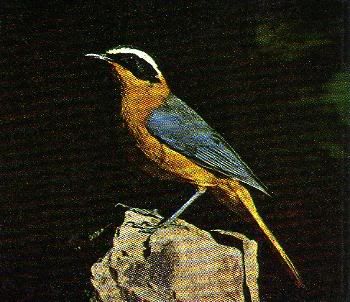

Above: WHITE-BROWED ROBIN (Heuglin's Robin). Characteristic white eyebrow; one of Rhodesia's finest singing birds; song emotional and ventriloquial; repetitive phrases reaching crescendo. Food: insects. Common in bush areas and gardens.

Above: TAWNY FLANKED PRINIA. Warbler-like bird distinguished from other prinias by plain
underparts; characteristic "weeping" alarm note. Food: insects. Oval nest woven of green
grass and fibres, typical of prinias. Generally well distributed in coarse vegetation, usually
near water, in pairs or small parties.
underparts; characteristic "weeping" alarm note. Food: insects. Oval nest woven of green
grass and fibres, typical of prinias. Generally well distributed in coarse vegetation, usually
near water, in pairs or small parties.

Above: WHITE-FLANKED FLYCATCHER. Male has lovely golden eye; hunts actively for insects, hopping along branches or flying out of them; voice, falling three-note whistle; typical flycatcher's bowl-shaped nest. Common resident, frequenting drier forest savannas or dry river beds in pairs.,

Above: CAPE WAGTAIL. Characteristic bobbing tail; grey-brown upper parts, dark band across chest and white outer tail-feathers; general favourite; protected; well-accustomed to human habitation; usually seen singly, in pairs or family parties in gardens or near water. Food: mainly insects and sand-hoppers, captured with great agility and dexterity. Voice: varied, loud and clear; often nests about houses. Commoner South African resident.

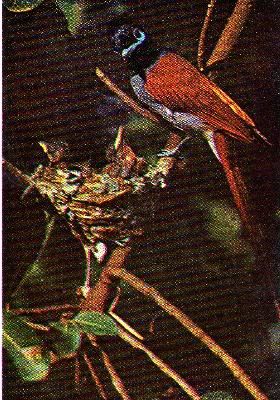

Above: CRIMSON-BREASTED SHRIKE. One of Rhodesia's most brilliantly coloured birds; characteristic white wing bar, brilliant scarlet from under tail to chin; not very shy but quick-moving; takes long hops on ground. Food: insects. Usually sings in duet. Strictly confined to acacia thorn veld where it builds shallow basin-shaped nest in fork of thorn tree. Eggs pale greenish white with clearly defined spots. Common Matabeleland.

Above: PARADISE FLYCATCHER. Beautiful long-tailed male; catches prey on wing, in undulating flight; small egg cup nest of moistened lichen. Common wet-season migrant, frequenting gardens, riverine vegetation, wood- lands.

Above: FISCAL SHRIKE (Butcher Bird);. Notoriously cruel; impales some prey on thorns or barbed wire. Diet: very varied; largely beetles, grasshoppers, but also other birds. Call: harsh grating challenge. Common throughout.

Above: GLOSSY STARLING. There are four species of the beautiful short-tailed glossy starling in Rhodesia, but it is impossible to differentiate in the field. Nest in natural holes in trees. Food: insects, fruit and occasionally seeds. Very common throughout.

Above: PLUM-COLOURED STARLING. Male brilliant; female dull; Intra-tropical migrant; usually frequents "Brachystegia"; nests in holes in trees. Food: insects, fruit. Common during rains.

Above: SCARLET-CHESTED SUNBIRD. Males brightly coloured, females dull (as in all sunbirds); characteristic finely pointed curved bill of sun-birds for puncturing flowers and extracting nectar; also eats insects; often nests near hornets or inside thick spiders' webs; unrestricted to definite habitat; generally distributed and common.

Above: MASKED WEAVER. Typical of the many varieties of weaver occurring in Rhodesia. Food : seed, insects, soft parts of flowers and fruits. Nesting; colonies by streams or open woodland; hanging nest with inverted entrance; common throughout.

Above: RED-BILLED QUELEA. Unmistakable; main menace to seed-growing farmers throughout Africa. Swift-flying flocks sometimes number millions (lower picture); nests in hundreds of thousands; mainly low-lying areas; widely distributed.


Above: RED BISHOP. Same sub-family as masked weaver and quelea; red only in breeding season, brown and sparrow-like rest of year; grain pest. Common throughout vleis and swamps below 6,500 feet.

Above: PIN-TAILED WHYDAH. Promiscuous; usually seen with several females; becomes
dull sparrow-like bird in dry weather; eggs laid mainly in waxbill's nests; young reared by them. Food: seeds. Common.
dull sparrow-like bird in dry weather; eggs laid mainly in waxbill's nests; young reared by them. Food: seeds. Common.

Above: RED - THROATED TWIN- SPOT (Peter's). Named from double white spots on belly. Food: grass seeds. Voice: a tinholing cricket-like sound; domed nest; frequents edges of
evergreen and riverine forest.
evergreen and riverine forest.

Above: RED-BILLED FIREFINCH. Closely associated with settlements; very tame; waxbill; often seen in camps and suburbs of towns. Food: seeds and small insects. Distinctive nasal "tweet, tweet" call. Widely distributed and common below 5,400 ft. in thickets and riverine scrub.

Above: BLUE WAXBILL. The only waxbill with pale blue underparts; tame, familiar little bird; a great favourite in aviaries; common around houses and gardens; often builds its round nest near wasps for protection. Very common throughout, especially in thorn veld.

Above: SWEE WAXBILL (South African). Distinctive combination of black tail, red rump and green back but quiet and easily overlooked; occurring at Zimbabwe Ruins. Food: grass seeds and small insects. Voice: gentle "swee, swee". Recumbent pear-shaped nest; rare here; common South of Limpopo.

Above: CAPE CANARY. Distinctive grey head; male much brighter. Food: seeds. Loud, wild song reminiscent of English lark; small basin-shaped nest built entirely by female over some two weeks; large noisy flocks gather at dusk. Restricted to Eastern Highlands.
END OF ARTICLE
This guide reprinted from Rhodesia Calls by Graphic Printers, Rhodesia, and published by the Rhodesia National Tourist Board.
Publication was made available to ORAFs by Lewis Walter Thank you Lewis
Acknowledgement and Appreciation
Paul Norris for the ISP sponsorship.
Paul Norris for the ISP sponsorship.
Paul Mroz for the image hosting sponsorship.
Robb Ellis for his assistance.
Should you wish to contact Eddy Norris please mail me on orafs11@gmail.com
Comments are always welcome.
Comments are always welcome.
Extracted and recompiled by Eddy Norris for use on "Our Rhodesian Heritage" blog.
* The birds shown in the pictures arc named according to the listing in Roberts* Birds of Southern Africa.


0 Comments:
Post a Comment
Subscribe to Post Comments [Atom]
<< Home